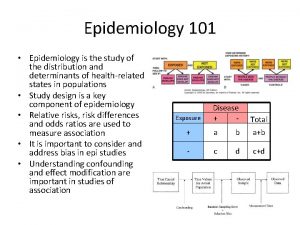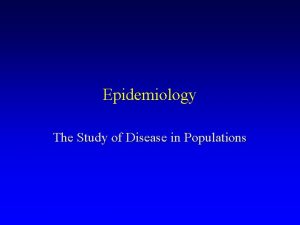Epidemiology 101 Epidemiology is the study of the









- Slides: 9

Epidemiology 101 • Epidemiology is the study of the distribution and determinants of health-related states in populations • Study design is a key component of epidemiology • Relative risks, risk differences and odds ratios are used to measure association • It is important to consider and address bias in epi studies • Understanding confounding and effect modification are important in studies of association Disease + - Total + a b a+b - c d c+d Exposure

Overview of Genetic Epidemiology • Different study designs in genetic epidemiology answer different questions about genetic basis of disease. • Collecting family data and family history data is important but challenging. • Pedigrees provide visual representations of family data.

Segregation and Linkage Analysis • Complex segregation analysis is a modeling approach for evaluating the transmission of a trait within a pedigree. • Linkage analysis focuses on the co-segregation between a marker locus and a putative disease locus using family data.

Linkage Disequilibrium • • LD refers to nonindependence of alleles Measures of LD include D, D’ and r 2 LD is exploited for association studies, imputation and GWAS LD in turn causes challenges in interpreting association findings and identifying the causal allele(s)

Association Studies • Focus on association between a particular allele and disease in a population. • Need to consider potential impact of population stratification. • Family based association studies. • Need to consider power and sample size in design and analysis of association studies. Population based Association studies

Genome Wide Association Studies • GWAS perform association analysis on markers across the genome. • Standards for QC, analysis and presentation. • GWAS have been highly successful at identifying common variants with modest effect sizes associated with disease. • Post-GWAS studies focus on functional characterization and epidemiologic interpretation. • Increasing examples of applications of GWAS findings.

Gene-Environment Interactions • Focus on interplay between genetic and environmental factors • Need to consider scale (additive and multiplicative) • Novel methods to improve power • Attention needs to be given to measuring and analyzing both the G and the E

Sequencing Studies • Next-generation sequencing allows us to examine rare and lowfrequency variants. • Gene-level tests are sometimes needed to evaluate this data. • Family based study designs can be useful for identifying rare variants associated with disease phenotypes.

Precision Medicine
 What is descriptive study in epidemiology
What is descriptive study in epidemiology Rumus odds ratio
Rumus odds ratio Nutritional epidemiology definition
Nutritional epidemiology definition Logistic regression epidemiology
Logistic regression epidemiology Prevalence rate formula
Prevalence rate formula Cross sectional study advantages and disadvantages
Cross sectional study advantages and disadvantages Attack rate calculation
Attack rate calculation Difference between descriptive and analytical epidemiology
Difference between descriptive and analytical epidemiology Descriptive epidemiology
Descriptive epidemiology Difference between descriptive and analytical epidemiology
Difference between descriptive and analytical epidemiology

















